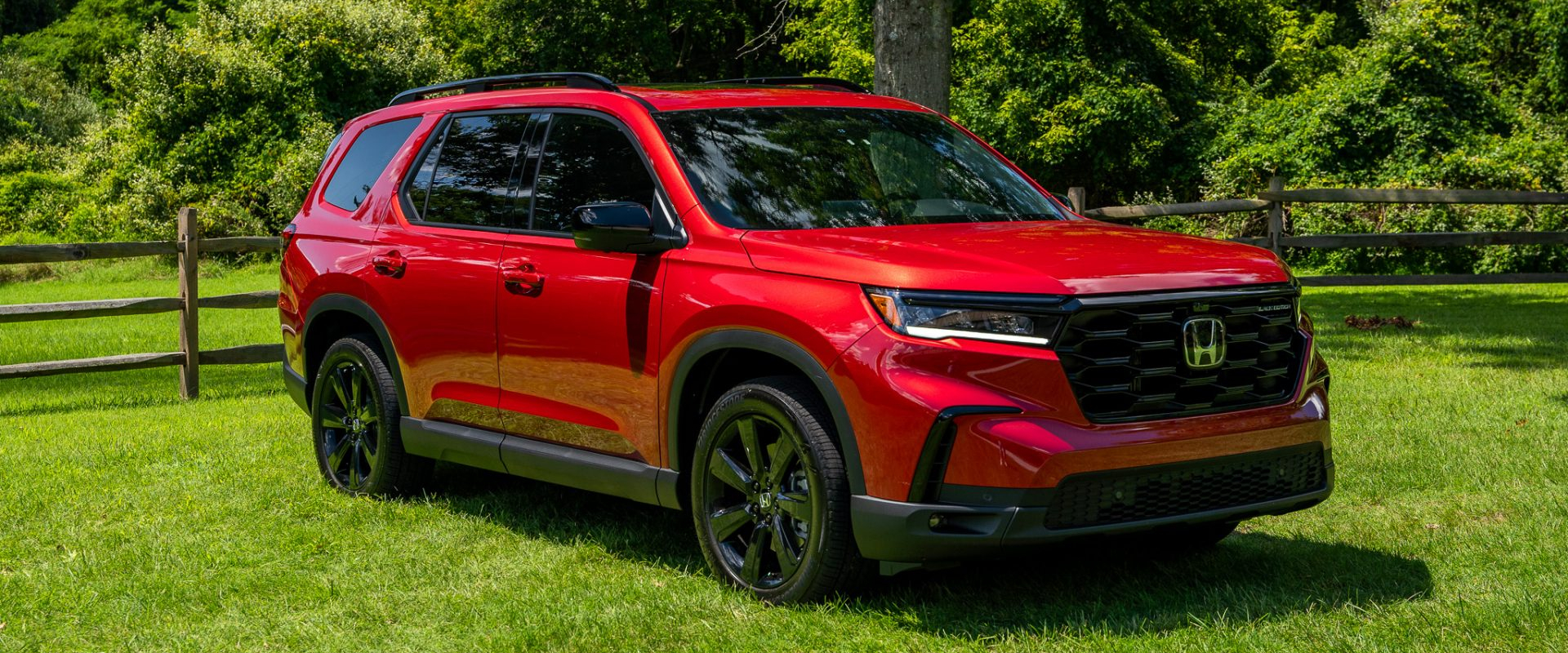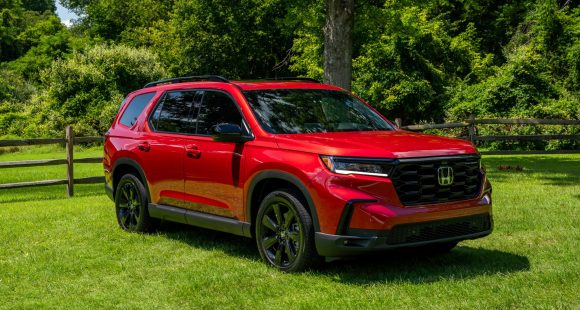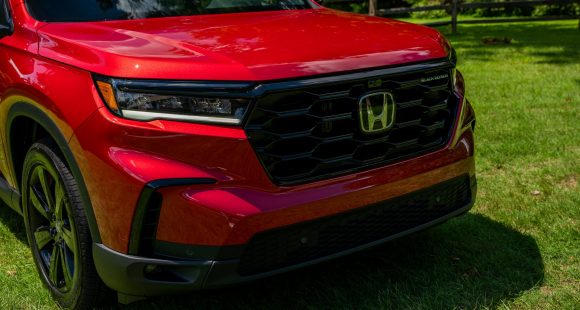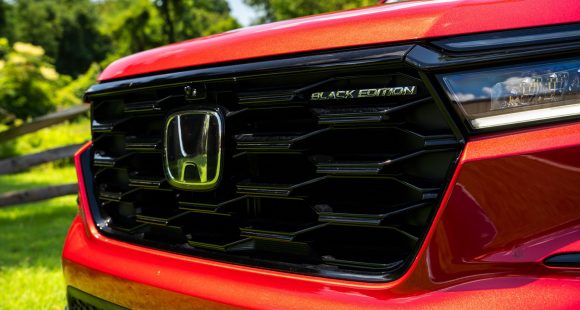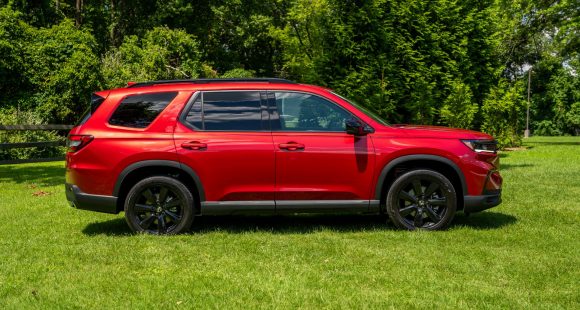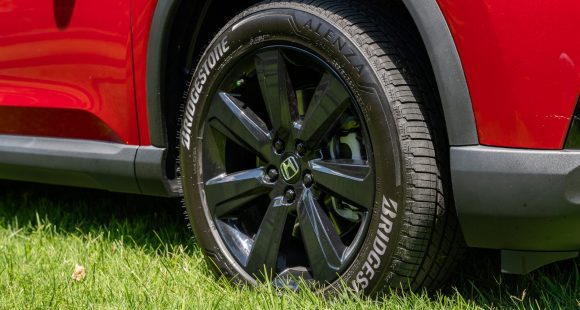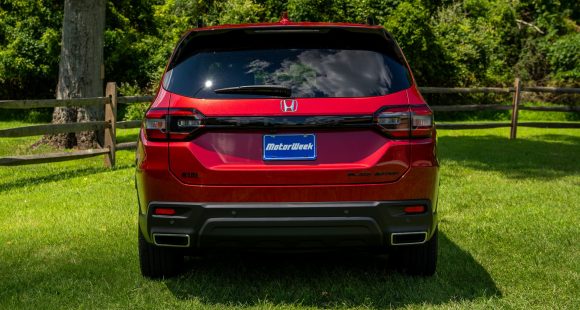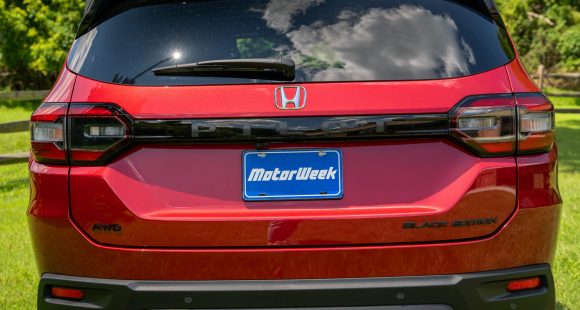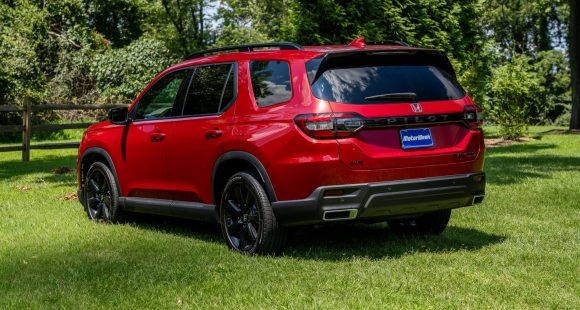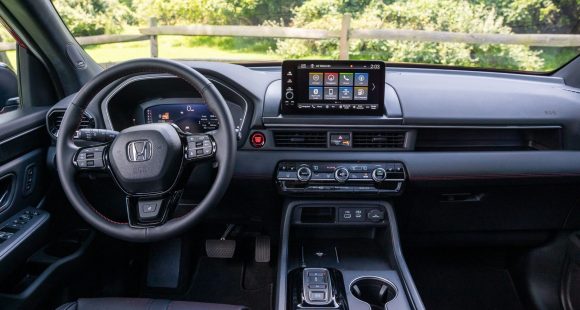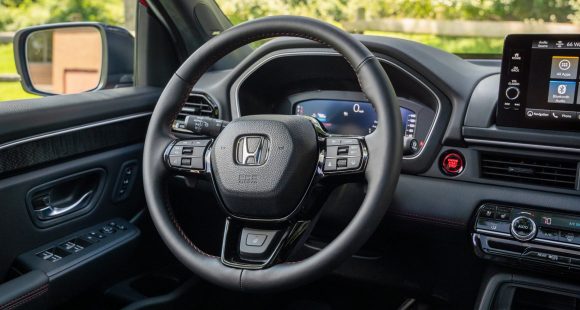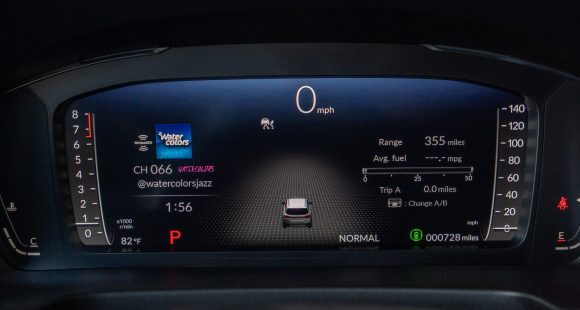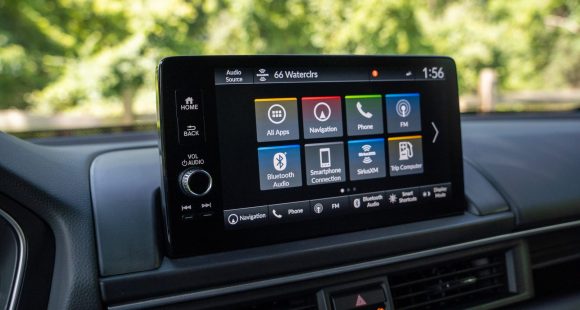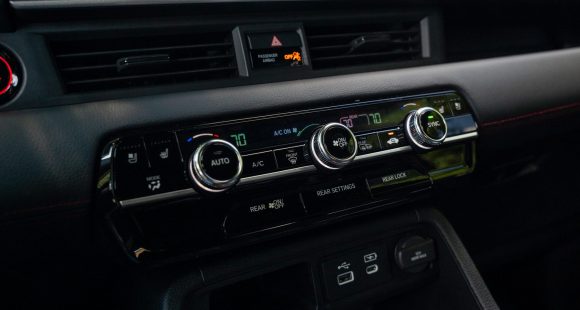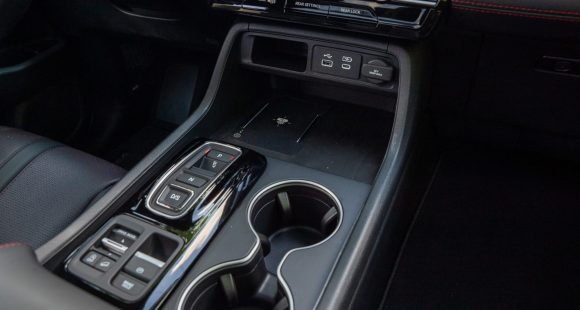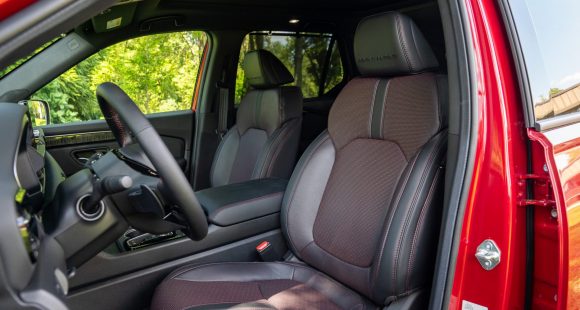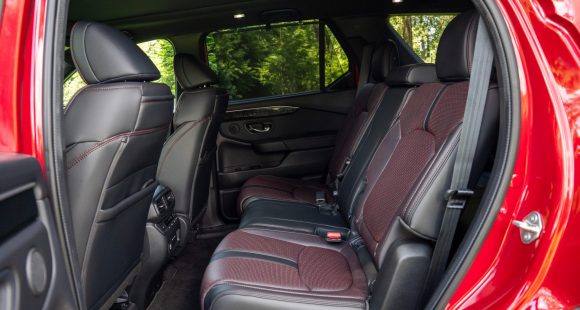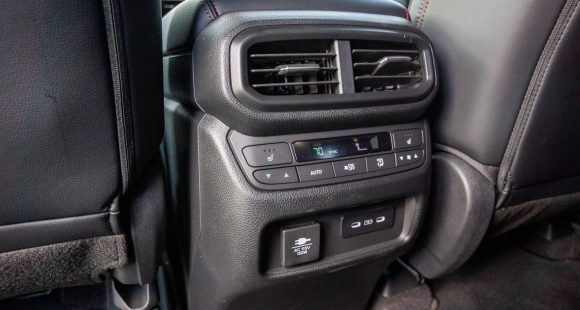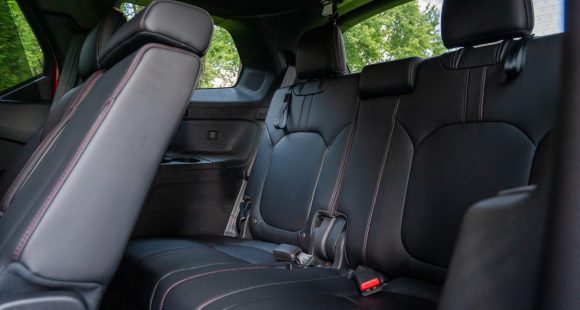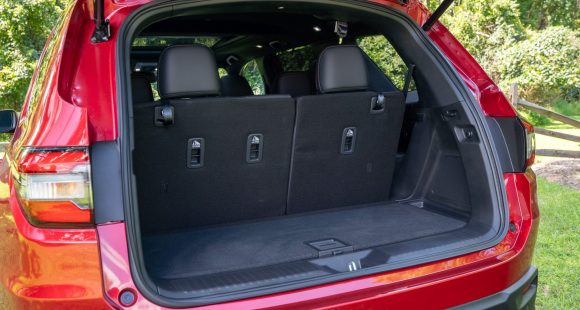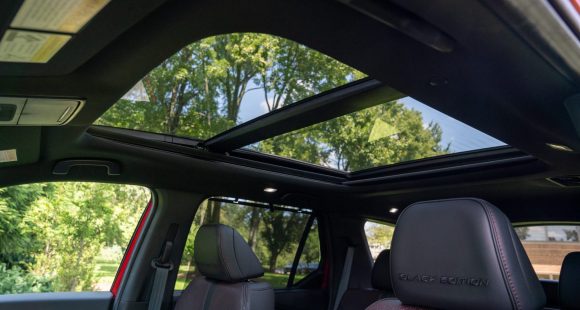2018 Range Rover Velar
When Jaguar entered the SUV world with the F-PACE, we raved about the excellence of their mostly ground up design. After all, they could have simply rebadged a ute from their cousin Land Rover. Now, as it turns out, it’s Land Rover doing some reverse engineering, with a new SUV based on the F-PACE, the Range Rover Velar.
If you’re not a Land Rover enthusiast, you might wonder where this 2018 Range Rover Velar fits in. Well, it’s a true midsize entry, slotting in between the larger Range Rover Sport and compact Evoque.
Engine choices are in step with the Jaguar F-Pace; 2.0-liter turbo-4s, one diesel one petrol, and a 3.0-liter supercharged V6 that rates 380-horsepower and 332 lb-ft. of torque. All work with a ZF 8-speed automatic transmission.
But lest you think this is simply old-school badge engineering, know that Land Rover engineers did indeed start with the bare bones of the F-Pace, including maintaining its 113–inch wheelbase. But from there, they created an all-new Range Rover.
 And certainly a high-fashion one. With no obvious resemblance to the F-Pace; just plenty of styling cues from other Land Rovers; with a floating roof design, some snazzy fender trim, and pop out door handles thrown in for good measure. All standing on up to 22-inch wheels.
And certainly a high-fashion one. With no obvious resemblance to the F-Pace; just plenty of styling cues from other Land Rovers; with a floating roof design, some snazzy fender trim, and pop out door handles thrown in for good measure. All standing on up to 22-inch wheels.
More emphasis was put on off-road performance as well. So, in addition to standard all-wheel-drive, the Velar is available with Terrain Response 2, and gets an electronic air suspension setup not obtainable on the F-Pace, at least for now anyway. And, it’s not just pretty, with a towing capacity of 5,500-lbs.
Admittedly, handling prowess has been lost in the process, as the Velar doesn’t feel quite as light on its feet as the F-Pace, but ride quality is truly sublime.
Dialing up Dynamic mode helps it feel it’s sportiest, and owners can dial in their own customized setup.
Maintaining their superior off-road image is vital to Land Rover, and the Velar is truly more capable than most will ever experience. It also feels rock solid with its aluminum monocoque chassis construction. There’s no ability to engage a low range; but the full suite of electronic aids specific for the trail, have the ability to send full power to whichever wheel is getting the most traction, getting you through just about anything you might encounter.
 Of course you’re well-swaddled in Range Rover luxury while doing that, including numerous leather packages, and supremely comfortable seats. It’s a gorgeous look.
Of course you’re well-swaddled in Range Rover luxury while doing that, including numerous leather packages, and supremely comfortable seats. It’s a gorgeous look.
This is certainly not your father’s Land Rover, unless he had his own proprietary touch panel control system installed. Here it’s Land Rover’s new InControl Touch Pro Duo with twin 10-inch capacitive touchscreens.
With few traditional physical controls, it can be intimidating when you first hop in, but it’s a mostly-logical setup that doesn’t take too long to get comfortable with.
Rear seat passengers don’t miss out on the luxury treatment either, and space is among best in class.
As is cargo room, 34.4 cubic-ft. behind the 2nd row, 70.1 with the 40/20/40 split seatbacks folded flat.
All of that makes this Range Rover as functional as it is beautiful.
 As for track work, our supercharged V6 Velar hopped off the line eagerly with good all-wheel-drive grip. The rear really squats down as you take off, hitting 60 in 5.5-seconds.
As for track work, our supercharged V6 Velar hopped off the line eagerly with good all-wheel-drive grip. The rear really squats down as you take off, hitting 60 in 5.5-seconds.
And right away, you realize Jaguar kept all of the cool exhaust notes for themselves, as here you just get some droning engine noise. Shifts are quick and smooth however, taking you through the ¼-mile in 14.0-seconds flat at a nice even 100 miles-per-hour.
It was a difficult task determining what exactly its capabilities are in the handling department. The chassis feels proficient enough, but as soon as there’s even a hint of understeer, the “safety at all costs” computer initiates “priority slow down procedures” and starts triggering the brakes.
It does exhibit only minor body roll throughout the cones however, with medium to light steering.
And just 102-feet is all it took to bring this thing to a halt from 60. Some nose dive is to be expected bringing 4,471-lbs. to a complete stop that quickly, but even that was relatively minor.
Government Fuel Economy Ratings for the V6 are 18-City, 24-Highway, and 20-Combined. We averaged a fine 21.7 miles-per-gallon on the required Premium. That makes for an Energy Impact Score slightly below the average for all cars, with annual oil consumption of 16.5-barrels and CO2 emissions of 7.3 tons.
A wide range for this Rover has prices starting at just $50,895, and stretching to at least $78,095 for an R-Dynamic HSE V6; our tester was closer to $90,000. Yikes!
Still, if you’re like us, your first response to the middle-weight 2018 Range Rover Velar may be “just what we needed, another luxury SUV”. But, Land Rover has been building posh off-roaders for longer than anybody, so it’s always good to see what they’re up to next. Now it’s up to the rest of the segment to see if they can keep up with the Velar.
Specifications
- Engine: 3.0 liter
- Horsepower: 380
- Torque: 332 lb-ft.
- 0-60 mph: 5.5 seconds
- 1/4 mile: 14.0 seconds @100 mph
- EPA: 18 mpg city / 24 mpg highway,
- Energy Impact: 16.5 barrels of oil/yr
- CO2 Emissions: 7.3 tons/yr
2024 Toyota Land Cruiser
Toyota’s Go Anywhere Globetrotter Returns To U.S.
Every once in a while, we all need a reset. A time to get back to basics and prioritize the things that really matter. Well, for the Toyota Land Cruiser that time is now. So, let’s find out if that means bigger and better things for Toyota’s iconic off-roader.
The Toyota Land Cruiser’s status among the global off-road community is legendary, and it’s hard to imagine there’s any corner of the earth where a Land Cruiser hasn’t kicked up a little dust or mud. Well, 2024 sees the return of the Land Cruiser to the U.S. market after a 3-year hiatus, getting a major reset for the journey.
The reset comes mostly by no longer being based on the large three-row “300-series” chassis, but a new version of the smaller “200-series,” now known as the J250. As with the latest Tacoma, it uses the Tundra pickup’s full-size steel frame.
While the main Land Cruiser model, which goes by simply Land Cruiser, is packed full of luxury and convenience features, there is also a stripped-down model known as the 1958, honoring the first year the Land Cruiser made landfall here in North America. And it is that 1958 we have here, and we were glad to see it, as it also celebrates the original’s back-to-basics approach as a blank canvas for you to personalize as you tackle more and more adventures.
Not that it’s fully stripped down, as 8-inch touchscreen infotainment, a 7-inch full-color multi-information display, and automatic climate control are still standard. Plus, some seriously durable materials, and great heated cloth front seats that throw off some get serious 1990s Tacoma vibes.
But outside, there’s a definite lack of flashy trim and basic looking 18-inch wheels with Yokohama Geolander all-season tires; plus, big chunky bumpers and tilt-up back glass, which is a rarity that we appreciate. Though there is a little too much plastic in places that are sure to see some abuse if you do any significant off-roading.
It even feels a little rough around the edges, but for us it just adds to the rugged old-school utility vibe in a good way.
We did just that, both here in the Mid-Atlantic as well as in the California desert; and while there are some tech-forward driving aids, the actual hardware is in most cases plenty to get things done. That includes standard full-time dual-range four-wheel-drive, locking center and rear diffs, and 8.7-inches of ground clearance. A front stabilizer bar disconnect is also available to allow for increased articulation.
Who needs a V6 or even a V8 when you’ve got Toyota’s i-FORCE MAX setup at your disposal with 326 horsepower and 465 lb-ft of torque coming from a 2.4-liter turbo-four with an electric motor sandwiched between the engine and its eight-speed automatic transmission. Low speed torque delivery is impressive. It even feels a little rough around the edges, which may be a turn off to some, but for us it just adds to the rugged old-school utility vibe in a good way.
And it certainly feels quicker than an off roader needs to be, with an instant torque dump as soon as we eased on the throttle at our Mason Dixon test track; helping us get to 60 in 8.1 seconds and through the quarter-mile in 16.3 seconds at 86 mph. Considering the Land Cruiser’s terrain conquering mission, it behaved quite well in our handling course; it was plenty responsive to inputs, with less body roll than we expected and plenty of grip from the tires. The steering was light and quick but as expected didn’t provide much feel. Other than significant nosedive, braking performance was exceptional. Only 107-feet to panic stop us from 60 mph.
With the shift to the smaller size, there’s no more third row available, and cargo capacity now comes in at 46.2 cubic-feet with a max of a still healthy 82.1. Now, the best part of the Land Cruiser’s return is the entry price of $57,445. That’s about 30-grand less than what the last Land Cruiser went for back in 2021.
Whether it’s over the top fashion trends, mullets, or zombies; just when you think they’re dead, they come roaring back to life. Of course, we’re much happier to see the resurrection of this 2024 Toyota Land Cruiser than any of those things. Toyota is one brand that still recognizes the value of full-framed rugged rigs and has also acknowledged that sometimes less really is more. The Godfather of Toyota off-roading is back and better than ever.
2025 Honda Pilot Black Edition
Honda’s Most Elite Pilot Gets More Elite
Honda began their Pilot crossover program back in 2003, and it didn’t take long to see that this three-row ute was ready for prime time. Now in its 4th-generation, Honda has created the most off-road capable Pilot yet, but this year, they focus on another set of enthusiasts. Time for us to shine a line on this new Black Edition.
Honda has certainly been an elite performer in the SUV world since their CR-V first hit the pavement in the late 1990s. So much so, they’ve been using the term “elite” to mark their top trim level for years now.
Well, things rarely stay the same for too long in the car marketing world. Combine that with buyers willing to pay more and more for added bling, and there’s a new king of the Honda hill; Black Edition. Seen here on this 2025 Honda Pilot Black Edition.
Now the 4th generation Pilot was all-new for 2023, and after our test of the new off-road inspired TrailSport version, we were eager to get a taste of the finer things of Honda life. Now the Black Edition doesn’t so much add features, as ratchet up the Pilot’s style game with 20-inch gloss-black wheels and unique trim inside and out.
For the exterior, that also means glossy dark treatments applied to the grille, side mirrors, window trim, air intakes in the front fascia, and rear bumper; plus, unique logos of course.
Inside, exclusive red accent stitching is applied to the seats, steering wheel, and door panels; plus, red accent lighting and Black Edition logos.
Like every Pilot, 3-row seating is standard. But, while both 1st and 2nd rows are very spacious, that 3rd row is best suited for kids, and the 1-touch access is about as easy as it gets.
Storage space is great too, and with multiple folding options for the 2nd row, it offers a lot of flexibility and a nice flat floor when everything’s folded. There’s 18.6 cubic-ft. of room behind the 3rd row, 48.5 behind the 2nd, and a giant 86.5 with all seatbacks folded.
Front seating is as comfortable as it is spacious, and while the Pilot’s 9-inch touchscreen is relatively small by the latest standards, it, as well as the rest of the controls, are simple and straightforward to operate.
Storage space is great too, and with multiple folding options for the 2nd row, it offers a lot of flexibility.
Producing the Pilot’s get-up-and-go is Honda’s familiar naturally aspirated 3.5-liter V6, outputting 285-horsepower and 262 lb-ft. of torque. It flows through a 10-speed automatic transmission to the front wheels. All-wheel-drive with Intelligent Variable Torque Management is available in Sport, EX-L, and Touring trims. It’s standard for TrailSport, Elite, and of course, Black Edition.
Power felt more than adequate on the street. But what about at our Mason Dixon test track?
Here too power felt strong off the line. But, our computer showed it tempered quickly, taking a longish 8.2-seconds to reach 60. That’s also quite a bit off the pace of the 6.8-seconds we saw in the TrailSport two years ago. Gear changes in the 10-speed automatic were very smooth, but also a little slow, as we worked our way to the end of the ¼-mile in 15.9-seconds at 90 miles-per-hour.
Minimal body roll and a moderate amount of understeer set the tone in our handling course, where this Pilot felt well planted and easy to control, with very little stability system intervention, even as we carried fairly high speeds through the cones.
Panic stops from 60 averaged a good 115-feet. There was a fair amount of nosedive, but results were quite consistent thanks to minimal fade.
So, despite a somewhat slow roll out, we were pleased with the Pilot’s overall very competent and safe track performance.
Back to the street, Government Fuel Economy Ratings, with all-wheel-drive are 19-City, 25-Highway, and 21-Combined; we averaged a good 24.2 miles-per-gallon of Regular.
The Energy Impact Score is slightly below average, using 14.2-barrels of oil annually, with CO2 emissions of 7.0-tons.
With a new top end trim level, Honda also eliminated one at the bottom; no more LX. Sport is now the base model starting at $41,595, with all-wheel-drive a $2,100 option. Top Black Edition starts at $55,975.
The Honda Pilot has been a leader in the 3-row SUV segment ever since it arrived on the scene for 2003, delivering capability, reliability, and driving dynamics well above its class norm. So, after focusing on off-road ruggedness in recent years, the 2025 Honda Pilot Black Edition adds a welcomed bit of black-tie flair to the Honda SUV party.
Specifications
As Tested
- Engine: 3.5-liter V6
- Transmission: 10-speed automatic
- Horsepower: 285
- Torque: 262 lb-ft.
- EPA: 19 City | 25 Highway | 21 Combined
- 0-60 mph: 8.2 seconds
- 1/4 Mile: 15.9 seconds at 90 mph
- Braking, 60-0 (avg): 115 feet
- MW Fuel Economy: 24.2 MPG (Regular)








